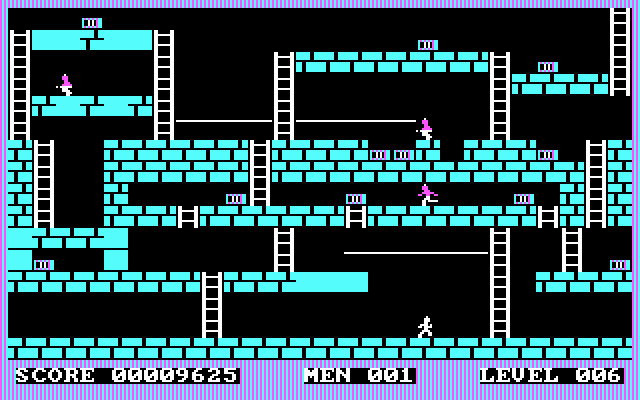

In late 1982, Smith sent this new version to four different publishers, among them Brøderbund and Sierra. He borrowed enough money to buy a color monitor and joystick for his Apple II, and programmed a second, much-improved version with color bitmap graphics and controls that took advantage of one of the Apple’s unique affordances: its joysticks had two buttons rather than the standard one, which in this case allowed the player’s avatar to drill to the left or right of himself without the player ever having to reach for the keyboard. Unfortunately, it does not fit with our product line.”īut, seeing how popular the game continued to be at the university, Smith decided to take another stab at it. After paying James Bratsanos $1500 for the rights to the game, he submitted it to Brøderbund Software, only to get a terse rejection letter back: “Thank you for submitting your game concept. Smith made just one big change: he renamed the game Miner to avoid legal entanglements. “After he bugged me enough,” said Smith in a 1999 interview, “one weekend I rewrote it for the Apple II, basically in three days.” This first microcomputer version was a copy of the DEC VAX version right down to its monochrome ASCII graphics. Along the way, it gradually evolved from an arcade game into something that required as much thought as reflexes the levels just kept getting more and more complex.Īccording to Smith, it was his eight-year-old nephew who convinced him to port the game to the Apple II having visited the computer lab once or twice and seen it in action there, the little boy was decidedly eager for a version he could play at home. Soon students were coming by only to play Kong Lamont claims that “a ‘show process’ command would often report 80 percent of the users running ‘graph.'” Eager players began to queue up behind the university’s computer terminals, and Kong became a fixture of campus life, the University of Washington’s equivalent of what Zork had once been at MIT. With its captive audience of playtesters in the form of the students who hung around the computer labs, the game grew organically as the weeks passed.
#Lode runner 2 deaths password
“‘Graph’ would prompt the user for a function,” remembers a fellow student named Rick LaMont, “then crap out unless the secret password was entered to play Kong.” The group hid their game from the university’s administrators by embedding it into an otherwise broken graphing program. Armed only with a pick axe that was more tool than weapon, you must steal all of the gold that was lying around the place, whilst avoiding or delaying the guards who protected it, generally by digging pits into which they could fall. In Kong, you guided a little man through a single-screen labyrinth of tunnels linked by ladders, implemented entirely using monochrome textual characters your man was a dollar sign, your enemies paragraph symbols. When their fellow students started to show some interest in what they were doing, they made the game publicly available. Bratsanos had first created Kong the previous year on one of his high school’s Commodore PET microcomputers, and the two were now in the process of porting it to one of the university’s DEC VAX-11/780 minicomputers. Meanwhile he had a part-time job in one of the university’s computer labs, where he met two other students named James Bratsanos and Tracy Steinbeck, who were tinkering with a game they called Kong, a not so-thinly-veiled reference to the arcade hit Donkey Kong. They just have write down where blocs should be and to specify their kind.In late 1981, Doug Smith was studying architecture and numerical analysis at the University of Washington in Seattle. We made this tool for game designer to help them create levels. We did not create a user interface for the editor so regular user will not be able to use it. Like the original game "Lode Runner - The Legend Returns" we decided to create a game editor. Weapons (bombs, glue pistols) to slow and escape from enemies or solve puzzles.Custom puzzles floor (wood, stone, glue) to make puzzles harder and fun.Player abilities (break a dirt cube, pick up an object, use an object).Each level belong to one of the world the player as to go throught : We made sure to insert every items and blocs we developped so far.

We made 4 levels to test and show our game.

Lode Runner is a single player game where level can be seen as puzzles.


 0 kommentar(er)
0 kommentar(er)
